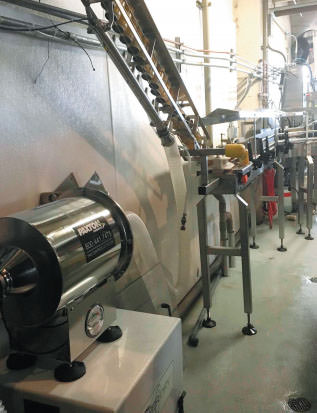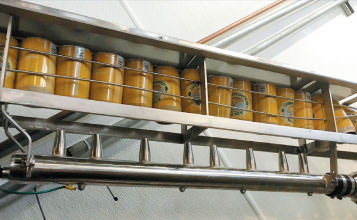posted on August 01, 2016 12:57


Anchor Brewery traces its roots back to the emigration of its first brewmaster, German brewer Gottlieb Brekle during the California Gold Rush. The 120-year old company now brews a range of drinks ranging from IPA to lager, and porter. With 100 employees in their main brewery facility in San Francisco, the company continues to grow with the opening of second brewery facility.
 Anchor now faces challenges based on its own growth and success. Its current brewery facility currently operates at maximum production capacity. And while they place a strong value on their historic past, Anchor is also known as one of the pacesetters for brewery technology. Anchor added a canning rail system in August 2014, and a new depalletizer in spring 2015, but the installation of these technologies left little room for movement in the production facility.
Anchor now faces challenges based on its own growth and success. Its current brewery facility currently operates at maximum production capacity. And while they place a strong value on their historic past, Anchor is also known as one of the pacesetters for brewery technology. Anchor added a canning rail system in August 2014, and a new depalletizer in spring 2015, but the installation of these technologies left little room for movement in the production facility.
When Anchor Packaging Manager Sean O’Neill learned about Paxton’s Ionizing Air Can Rinser (ICR) while attending the 2015 PACK Expo, he wanted to learn more about this new technology which enables craft brewers to reduce water usage while also saving money on ionized air. O’Neil toured the Ionizing Air Bottle Rinser (IBR) installation at Gordon Biersch Brewing, also located in the Bay Area. He was impressed by what he saw, but expressed doubts about Paxton’s ICR fitting within Anchor’s limited available space.
After visiting their facility, Paxton Western US Sales Manager Patrick Donovan was able to assure Anchor Brewing’s management team that he could install the compact yet efficient Paxton ICR in their plant. Donovan was on-site for the installation, using his engineering expertise to ensure that Paxton’s ICR fit within the facility’s confined space. He made sure the new ICR’s manifold was properly aligned, and fine-tuned the system’s Variable Frequency Drive (VFD).
 Two months after the installation of their Paxton Ionizing Can Rinser, the production team at Anchor Brewing is both amazed and delighted with the results. “We’ve been able to conserve water usage, which is a huge consideration here in California,” says Production Manager O’Neil. “I wasn’t sure they’d be able to fit this new technology into our space, but their equipment is more compact and efficient than I thought. Paxton provided excellent customer service, working with our unique requirements, and their Ionizing Can Rinser is easy to use.” Anchor plans to expand their use of Paxton’s technology in their planned new and larger facility, implementing an Ionizing Bottle Rinser, similar to that they saw at Gordon Biersch.
Two months after the installation of their Paxton Ionizing Can Rinser, the production team at Anchor Brewing is both amazed and delighted with the results. “We’ve been able to conserve water usage, which is a huge consideration here in California,” says Production Manager O’Neil. “I wasn’t sure they’d be able to fit this new technology into our space, but their equipment is more compact and efficient than I thought. Paxton provided excellent customer service, working with our unique requirements, and their Ionizing Can Rinser is easy to use.” Anchor plans to expand their use of Paxton’s technology in their planned new and larger facility, implementing an Ionizing Bottle Rinser, similar to that they saw at Gordon Biersch.
Quantifying the Solution
Paxton’s Ionizing Bottle Rinser completely replaced water rinsing at the facility for rinsing the inside of the bottles. Switching to Paxton’s Ionized Air System enabled the company to avoid expensive governmental fines implemented due to California’s severe water shortage.
The new bottle rinsing system at the customer’s facility air rinses the bottles at a line speed of 400 bpm, the same speed as was used with water rinsing, so production capacity was maintained. And although this line speed is slower than that of large soft drink manufacturers; it is suitable for medium size craft brewers and other bottlers producing beverages that emphasize craft quality in smaller batches rather than high production volume.
An added benefit was the Paxton IBR’s noticeable impact on Target Percentage of Oxygen (TPO). Bottles rinsed using Paxton’s IBR revealed a TPO 3 points lower than bottles that were water rinsed. This finding surprised and delighted the QC staff at the brewery, who had not anticipated the improvement in TPO when switching to air rinsing
Quantifying the Solution
Paxton’s Ionizing Bottle Rinser completely replaced water rinsing at the facility for rinsing the inside of the bottles. Switching to Paxton’s Ionized Air System enabled the company to avoid expensive governmental fines implemented due to California’s severe water shortage.
The new bottle rinsing system at the customer’s facility air rinses the bottles at a line speed of 400 bpm, the same speed as was used with water rinsing, so production capacity was maintained. And although this line speed is slower than that of large soft drink manufacturers; it is suitable for medium size craft brewers and other bottlers producing beverages that emphasize craft quality in smaller batches rather than high production volume.
An added benefit was the Paxton IBR’s noticeable impact on Target Percentage of Oxygen (TPO). Bottles rinsed using Paxton’s IBR revealed a TPO 3 points lower than bottles that were water rinsed. This finding surprised and delighted the QC staff at the brewery, who had not anticipated the improvement in TPO when switching to air rinsing